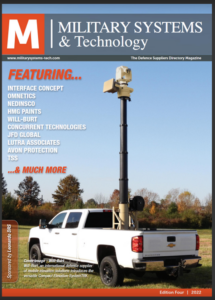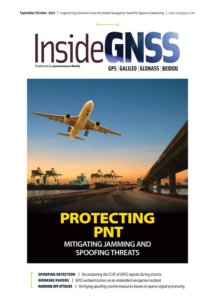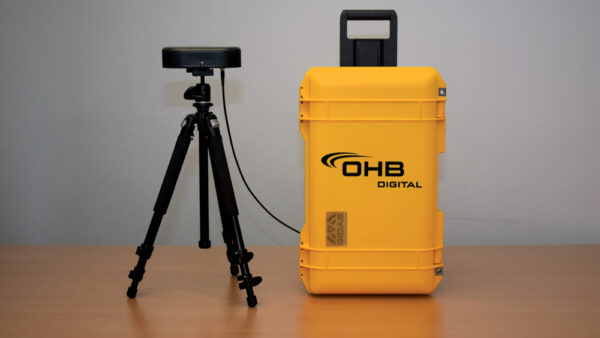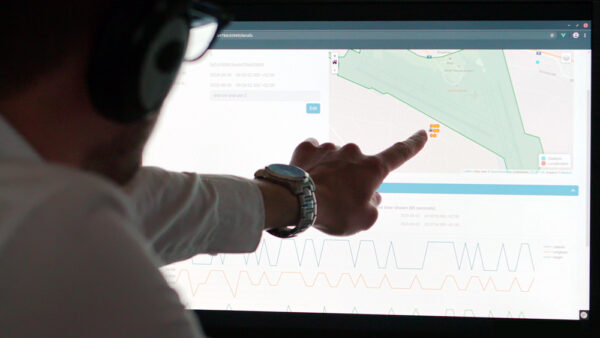GNSS / GPS Quality
Why GNSS Quality Assurance?
Global Navigation Satellite Systems (GNSS) positioning and timing services form the backbone of many applications and markets. Civilian GNSS services are free of charge and globally available but insufficiently protected against unintentional and even intentional disturbances. OHB Digital Solution researches for more than 20 years on how to provide means to monitor and augment the GNSS services with GNSS quality assurance. For many applications, it’s not only precision that matters, but predominantly integrity too! Our knowledge and experience in GNSS quality assurance are available in many different forms in our GIDAS product family.
Jamming & Spoofing
GNSS is globally and freely available, but vulnerable to many threats. The signals transmitted from GNSS satellites orbiting the earth at approximately 20.000 km altitude above the earth’s surface are very weak with the transmission power of a 100W light bulb (depending on the constellation and satellite generation). The signals are received on the earth’s surface with a signal power below the thermal noise floor. These weak signals can be disturbed or degraded by many sources. The main classifications of local interferences are:
- Out of band interference and unintentional interference
This type of interference can be caused by services using neighboring frequency bands or environmental influences (e.g., GNSS multipath). It usually occurs in the vicinity of other infrastructure using radio frequency links.

- Jamming
The intentional attempt to interrupt the GNSS service by broadcasting higher-powered signals. With the discontinuation of GNSS positioning, the onboard system must fall back to alternative navigation systems. Especially during challenging conditions, this can raise the likelihood of accidents.

- Spoofing
The intentional attempt to force a GNSS receiver to a false position/course can be challenging to detect. Spoofed GNSS receivers output false position and timing information, exposing the chance of collisions with the ground or other objects.

The first step in protecting your GNSS-dependent applications or platforms is to monitor the GNSS signal health on-location in real-time. While systems such as space-based augmentation systems (SBAS) or country-wide monitoring systems are typically designed to monitor the constellation health status (orbit-, satellite-clock-, uplink-errors), local interference or local anomalies are not visible. Especially for safety-critical applications, it is vital to monitor the GNSS signals and services as close to the application as possible.

FAQs:
What is GNSS?
GNSS stands for Global Navigation Satellite Systems. Every such system consists of several satellites (usually approximately 30), which are moving in precisely defined orbits around the earth, and continuously send radio signals to earth (in a frequency range of approximately 1,2 to 1,6 GHz. These signals can be received on earth and also above earth (for example, in airplanes). When receiving signals from at least four satellites the receiver can calculate a position and the time.
There exist several GNSS in parallel: GPS (operated by the US), the European GALILEO, GLONASS (also known as “Russian GPS”), BEIDOU from China – all of them supplying global coverage. In addition there exist navigation satellite systems which use the same mechanisms like the aforementioned GNSS, but cover only specific regions on the globe, like the Japanese QZSS system and Navic from India.
What is GNSS interference?
GNSS interference is the negative impact of other RF signals on a GNSS signal. It can happen unintentionally by e.g. multipath or intentionally by jamming or spoofing.
Who is affected by GNSS interference?
Everyone working with GNSS can be affected by GNSS interference: critical infrastructures, many industries, private users…
What is GNSS interference monitoring?
GNSS interference monitoring is the process of detecting, identifying, and locating sources of interference to GNSS signals. This can be done using a variety of methods, including:
-
- Signal analysis: This involves analyzing the characteristics of GNSS signals to identify any anomalies that may be caused by interference.
- Spatial correlation: This involves comparing the signals received by multiple GNSS receivers to identify any areas where interference is present.
- Direction finding: This involves using specialized equipment to determine the direction from which interference is coming.
Why is GNSS interference monitoring important?
GNSS interference can have a significant impact on the accuracy and reliability of GNSS-based applications. For example, interference can cause:
-
- Positioning errors: This can lead to accidents, injuries, and property damage.
- Timing errors: This can disrupt critical infrastructure, such as power grids and financial markets.
- Communication errors: This can interfere with communication between aircraft, ships, and other vehicles.
How is GNSS interference monitoring done?
Several different methods can be used to monitor GNSS interference. Some of the most common methods include:
-
- Ground-based monitoring: This involves using receivers on the ground to detect and identify sources of interference.
- Space-based monitoring: This involves using satellites to detect and identify sources of interference.
- Network-based monitoring: This involves using a network of receivers to detect and identify sources of interference.
What are the benefits of GNSS interference monitoring?
-
- Improved accuracy and reliability: GNSS interference monitoring can help to improve the accuracy and reliability of GNSS-based applications.
- Early warning: GNSS interference monitoring can provide early warning of potential interference events, which can help to mitigate the impact of these events.
- Law enforcement: GNSS interference monitoring can be used by law enforcement to track down and prosecute individuals who are responsible for intentional interference.
What are the challenges of GNSS interference monitoring?
-
- The dynamic nature of interference: Interference sources can be mobile, making it difficult to track and identify them.
- The low power of GNSS signals: GNSS signals are relatively weak, making them susceptible to interference from other sources.
- The cost of monitoring equipment: The equipment used for GNSS interference monitoring can be expensive.
What are the future trends in GNSS interference monitoring?
The future of GNSS interference monitoring is likely to be characterized by the following trends:
-
- Increased use of space-based monitoring: Space-based monitoring is becoming more affordable and reliable, which is likely to lead to increased use of this technology for GNSS interference monitoring.
- Increased use of network-based monitoring: Network-based monitoring is becoming more widespread, as it is a cost-effective way to monitor large areas for interference.
- Development of new technologies: New technologies are being developed to improve the accuracy and effectiveness of GNSS interference monitoring.
What is GNSS jamming?
GNSS jamming is the intentional emission of radio waves that interfere with GNSS signals. This can be done using a variety of devices, including:
-
- Handheld jammers: These are small, portable devices that can be used to jam GNSS signals in a small area.
- Vehicle-mounted jammers: These are larger devices that can be mounted on vehicles and used to jam GNSS signals in a larger area.
- Stationary jammers: These are even larger devices that are typically used to jam GNSS signals in a very large area.
What are the effects of GNSS jamming?
GNSS jamming can have a significant impact on the accuracy and reliability of GNSS-based applications. For example, jamming can cause:
-
- Positioning errors: This can lead to accidents, injuries, and property damage.
- Timing errors: This can disrupt critical infrastructure, such as power grids and financial markets.
- Communication errors: This can interfere with communication between aircraft, ships, and other vehicles.
How can I protect myself from GNSS jamming?
-
- Use a jamming-resistant receiver: These receivers are designed to be resistant to the effects of jamming.
- Use a diversity receiver: These receivers receive signals from multiple satellites, which can help to mitigate the effects of jamming.
- Use a signal-strength indicator: This will help you to identify areas where jamming is present.
What are the laws and regulations surrounding GNSS jamming?
The laws and regulations surrounding GNSS jamming vary from country to country. However, in general, jamming GNSS signals is illegal in most countries.
What are the future trends in GNSS jamming?
The future of GNSS jamming is likely to be characterized by the following trends:
-
- Increased use of jamming: As GNSS becomes more widely used, it is likely that the use of jamming will also increase.
- Development of more sophisticated jammers: Jammers are becoming more sophisticated, making them more difficult to detect and mitigate.
- Increased use of anti-jamming techniques: Anti-jamming techniques are being developed to help protect GNSS receivers from the effects of jamming.
What are the different types of GNSS jammers?
There are three main types of GNSS jammers:
-
- Continuous wave (CW) jammers: These jammers transmit a constant signal on the GNSS frequency band.
- Pulsed jammers: These jammers transmit a series of short pulses on the GNSS frequency band.
- Frequency-hopping jammers: These jammers transmit on a series of different frequencies within the GNSS frequency band.
How can I detect GNSS jamming?
-
- Using a signal-strength indicator: This will help you to identify areas where the signal strength is significantly reduced.
- Using a spectrum analyzer: This will allow you to see if there is any interference on the GNSS frequency band.
- Using a GNSS jammer detector: This is a specialized device that can detect the presence of GNSS jamming.
How can I mitigate the effects of GNSS jamming?
-
- Using a jamming-resistant receiver: These receivers are designed to be resistant to the effects of jamming.
- Using a diversity receiver: These receivers receive signals from multiple satellites, which can help to mitigate the effects of jamming.
- Using an anti-jamming technique: There are a number of anti-jamming techniques that can be used to help protect GNSS receivers from the effects of jamming.
What is GNSS spoofing?
GNSS spoofing is a malicious attempt to alter a user’s global navigation satellite system (GNSS) measurements, making their GNSS position unreliable. This is done by transmitting false GNSS signals that the receiver believes are authentic.
How does GNSS spoofing work?
The most common method of GNSS spoofing is to use a radio transmitter to broadcast false GNSS signals. These signals are typically transmitted on the same frequencies as the real GNSS signals, and they are designed to look as authentic as possible. When a receiver receives these false signals, it will believe that they are coming from real satellites, and it will use them to calculate its position.
What are the effects of GNSS spoofing?
GNSS spoofing can have a significant impact on the accuracy and reliability of GNSS-based applications. For example, spoofing can cause:
-
- Positioning errors: This can lead to accidents, injuries, and property damage.
- Timing errors: This can disrupt critical infrastructure, such as power grids and financial markets.
- Communication errors: This can interfere with communication between aircraft, ships, and other vehicles.
How can I protect myself from GNSS spoofing?
-
- Use a spoofing-resistant receiver: These receivers are designed to be resistant to the effects of spoofing.
- Use a diversity receiver: These receivers receive signals from multiple satellites, which can help to mitigate the effects of spoofing.
- Use a signal-strength indicator: This will help you to identify areas where spoofing is present.
What are the laws and regulations surrounding GNSS spoofing?
The laws and regulations surrounding GNSS spoofing vary from country to country. However, in general, spoofing GNSS signals is illegal in most countries.
What are the future trends in GNSS spoofing?
The future of GNSS spoofing is likely to be characterized by the following trends:
-
- Increased use of spoofing: As GNSS becomes more widely used, likely, the use of spoofing will also increase.
- Development of more sophisticated spoofers: Spoofers are becoming more sophisticated, making them more difficult to detect and mitigate.
- Increased use of anti-spoofing techniques: Anti-spoofing techniques are being developed to help protect GNSS receivers from the effects of spoofing.
What are the different types of GNSS spoofers?
There are two main types of GNSS spoofers:
-
- Rebroadcasting spoofers: These spoofers rebroadcast the signals from real satellites.
- Generating spoofers: These spoofers generate their own signals that are designed to look like the signals from real satellites.
How can I detect GNSS spoofing?
-
- Using a signal-strength indicator: This will help you to identify areas where the signal strength is significantly reduced.
- Using a spectrum analyzer: This will allow you to see if there is any interference on the GNSS frequency band.
- Using a GNSS spoofing detector: This is a specialized device that can detect the presence of GNSS spoofing.
How can I mitigate the effects of GNSS spoofing?
-
- Using a spoofing-resistant receiver: These receivers are designed to be resistant to the effects of spoofing.
- Using a diversity receiver: These receivers receive signals from multiple satellites, which can help to mitigate the effects of spoofing.
- Using an anti-spoofing technique: Several anti-spoofing techniques can be used to help protect GNSS receivers from the effects of spoofing.
What is GNSS timing?
GNSS timing is the use of GNSS signals to provide accurate timekeeping. GNSS signals are very precise, and they can be used to synchronize clocks over a wide area.
How does GNSS timing work?
GNSS timing works by receiving signals from multiple GNSS satellites. The receiver then calculates the time it takes for the signals to travel from the satellites to the receiver. This time is then used to synchronize the receiver’s clock with the clocks of the satellites.
What are the benefits of GNSS timing?
-
- Accuracy: GNSS timing is very accurate, and it can be used to synchronize clocks to within a few nanoseconds.
- Wide area coverage: GNSS signals can be received over a wide area, making GNSS timing a viable option for many applications.
- Robustness: GNSS timing is relatively robust to interference, making it a reliable option for many applications.
What are the applications of GNSS timing?
GNSS timing is used in a wide variety of applications, including:
-
- Financial markets: GNSS timing is used to synchronize clocks in financial markets, which helps to ensure that transactions are executed accurately and reliably.
- Power grids: GNSS timing is used to synchronize clocks in power grids, which helps to ensure that the grid operates efficiently and reliably.
- Telecommunications: GNSS timing is used to synchronize clocks in telecommunications networks, which helps to ensure that data is transmitted and received accurately.
What are the challenges of GNSS timing?
-
- Interference: GNSS signals can be interfered with by other radio signals, which can degrade the accuracy of GNSS timing.
- Spoofing: GNSS signals can be spoofed, which can result in inaccurate timekeeping.
What is the future of GNSS timing?
The future of GNSS timing is likely to be characterized by the following trends:
-
- Increased use: GNSS timing is becoming increasingly popular, and it is likely to be used in more applications in the future.
- Improved accuracy: GNSS timing is becoming more accurate, and it is likely to be even more accurate in the future.
- Lower cost: The cost of GNSS timing is declining, and it is likely to be even lower in the future.
Media:
-
GNSS Quality Productsheet

-
Military Systems & Technology
 Dec 2022
Dec 2022 -
The Marine Pilots’ Community
 Nov 2022 & Apr 2021
Nov 2022 & Apr 2021 -
InsideGNSS Digital Edition
 Sep-Oct 2022
Sep-Oct 2022 -
Military Systems & Technology
 Sep 2022
Sep 2022 -
Military Systems & Technology
 May 2022
May 2022 -
Military Systems & Technology
 Dec 2021
Dec 2021 -
InsideGNSS Magazine
 May-Jun 2021
May-Jun 2021 -
GPS World Magazine
 Mar 2021
Mar 2021 -
GPS World Magazine
 Jan 2021
Jan 2021 -
GSV Yearbook Mobility
 Dec 2020
Dec 2020




